Mood Board:
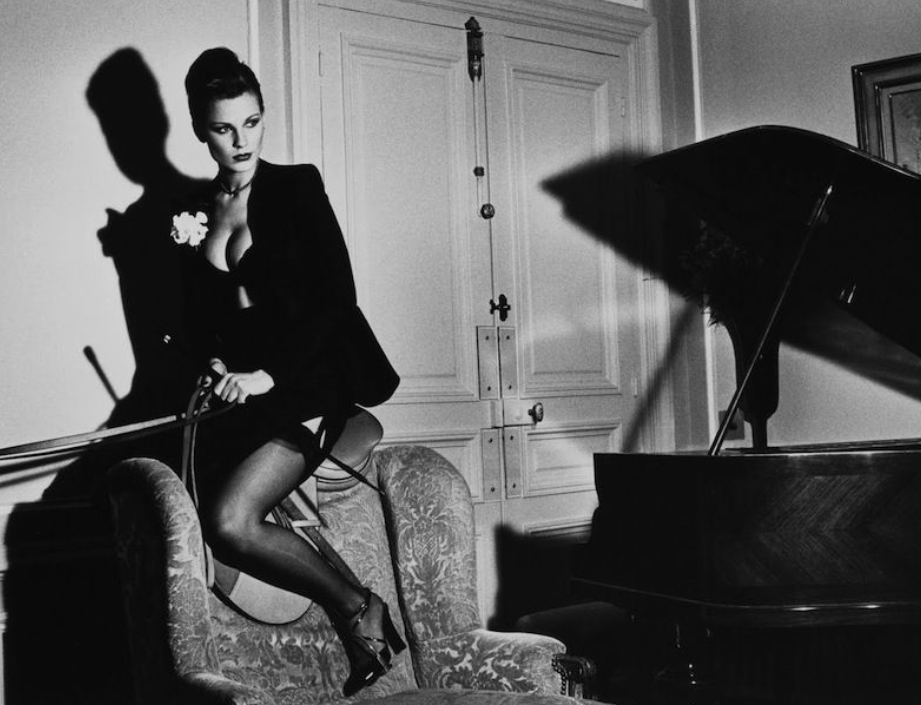
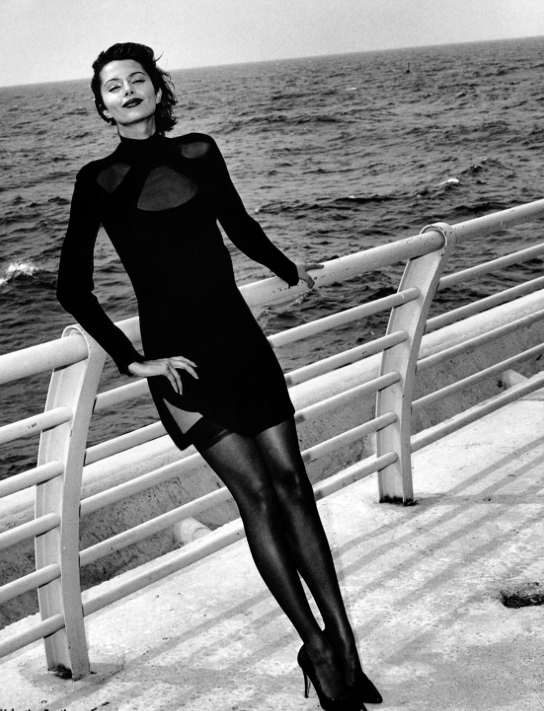
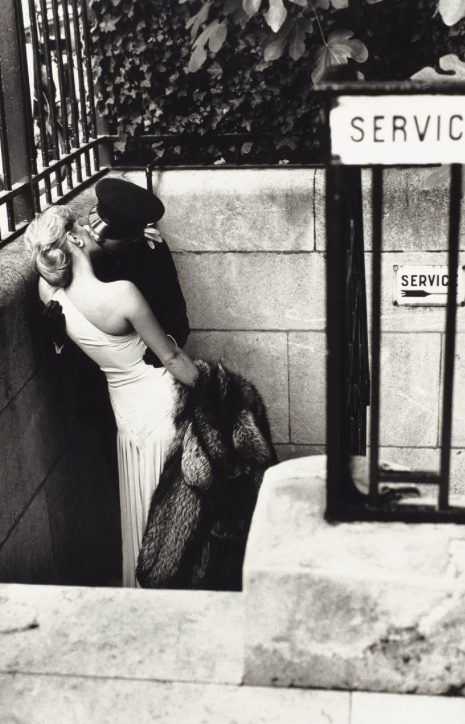
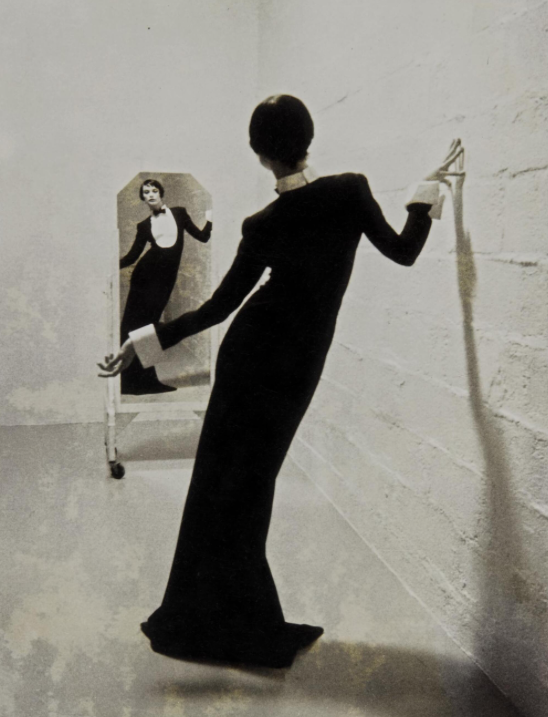
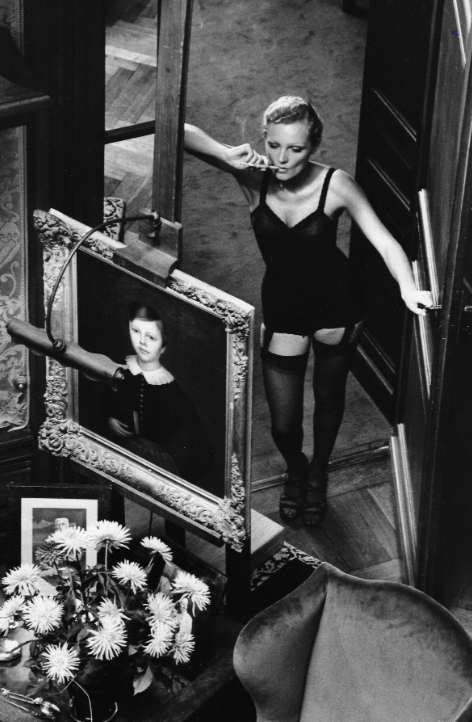
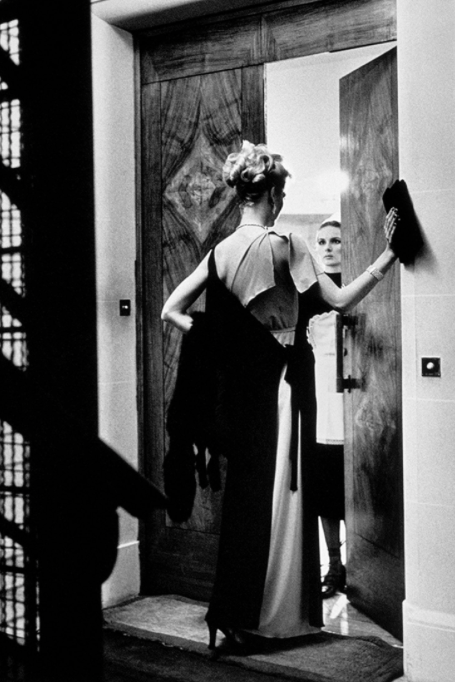
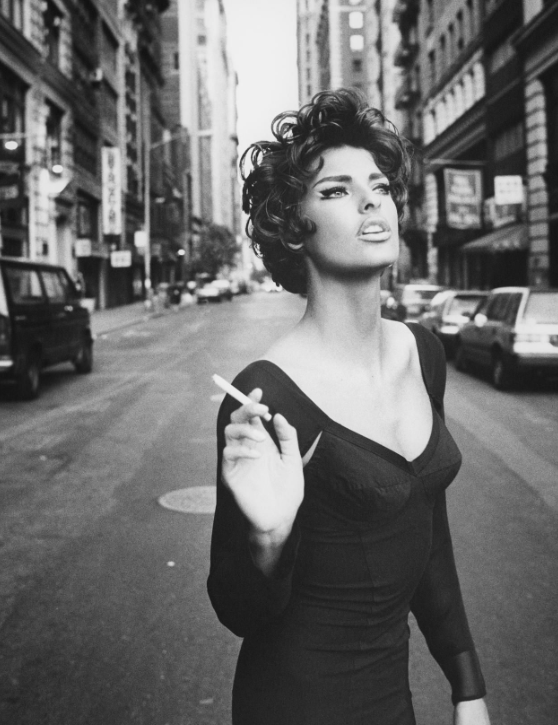
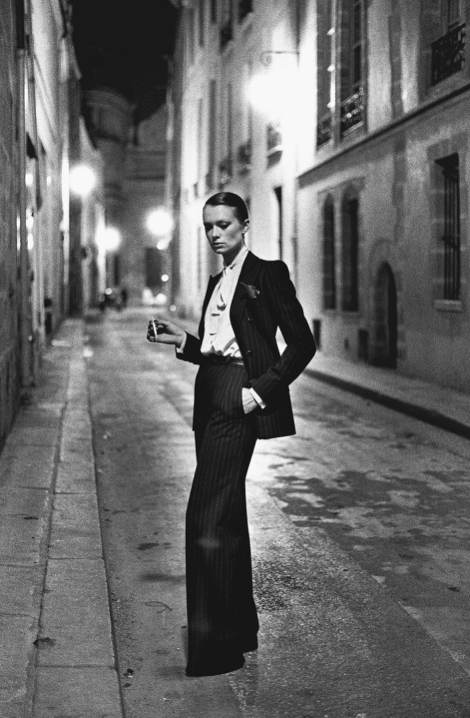
Mind map of Newton’s work:

Who is Helmut Newton?
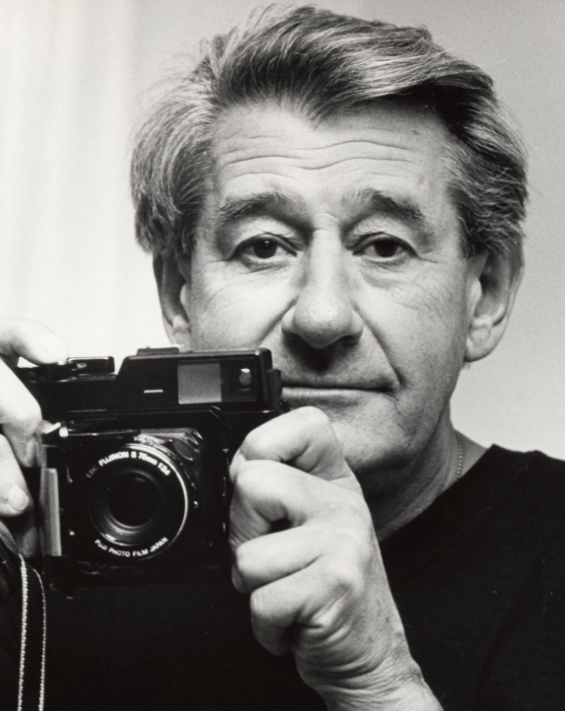
Helmut Newton was born on October 31st, 1920 and was a German-Australian photographer renowned for his provocative, highly stylised fashion photography that explored themes of eroticism, power and femininity. He passed away on the 23rd January 2004, yet is still one of the most influential photographer’s of women today. His work pushed the boundaries of visual culture, blending sensuality with stark and bold aesthetics. Newton’s influence continues to shape contemporary photography, fashion and visual art. Born in Berlin to a wealthy Jewish family, Newton began to develop an interest in photography early and then apprenticed with German photographer Eva. After World War II, Newton started his career in fashion photography, contributing to Australian publications. He began to grow popular when he moved to Paris in the 1950s, working for big fashion companies like Vogue Magazine. His distinctive style marked by elegance and stark compositions quickly gained him widespread recognition towards the 1970s, where his work had also appeared in major fashion publications such as Harper’s Bazaar and Elle.
Newtons common themes throughout his images are eroticism, voyeurism and power. His photographs often depict strong, sensual women in provocative poses, exploring tensions between desire, power and vulnerability. His work is described as “unapologetically erotic but also confronts the viewer with a sense of voyeurism, making them complicit in the act of looking”. He portrays women as powerful, dominant figures often dressed in sharp, tailored clothing or high heels reinforcing confidence and control, which was a new concept due to the traditional roles of women.
“I like photographing women who appear to know something of life.”
– Helmut Newton, Goodreads.com
This quote from the photographer himself shows his preference for capturing women who can exhibit life experience and are well educated, which highlights his feminist way of thinking. This quote also aligns with his admiration for strong women with a sense of power and domination, which also ties into traditional gender roles and challenging them.
Helmut Newton also stated:
“I love women. I love strong women.”
This statement also tells us that Newton celebrates empowerment, which carries on from the quote above. From this, I can infer that Newton admires women who are self-reliant rather than dependant on a man. This is challenging traditional female roles as women are often undervalued and only seen as objects of male desire. Historically, strength and power is as trait that is only associated with masculinity or affirm a belief in gender equality. By Newton attempting to break these stereotypes, he is allowing himself to gain recognition from the public as this was an uncommon thing to do in the 1970s, due to society being completely male-dominated.
How does Newton link to the theme of union?
Helmut Newton successfully links to the theme of union for my project through many aspects. One of the main ways is through blending art with fashion. His images which are often provocative create a union between commercial photography and artistic expression. By doing this, Newton brought together the aesthetic beauty of women, with deeper cultural values about femininity and empowerment. As he depicts women who embody sensuality in all of his work, this creates a union between traditional stereotypes and dominance, where he combines them together to reflect tension in a patriarchal society.
In addition to this, Newton interplays with light and shadow in his images to create a stronger dynamic with lots of depth. In all of his images, his use of stark contrasts between light and dark shadows create a strong contrast, and a dramatic aesthetic. The contrast between the light and the shadows symbolises binary opposites and uniting them to give a striking visual impact.
Lastly, Helmut Newton also explores human connection within his works. Specifically, they portray themes of intimacy and desire, which also links to objectification of women. In this way, the photographer manages to create a sense of unity through contrasting elements that usually oppose each other, as well as highlighting his feminist way of thinking when photographing his subjects.
Why did I choose to study Newton for my project?
I chose to study Helmut Newton for my project as his work holds significant cultural and historical value. This is because he revolutionised fashion photography with fine art which is a unique approach and differs from other artists who usually focus on one main element. I believe he had a big impact on fashion photography due to his feminist beliefs and the way he photographed women – in a provocative way where they hold power, rather than portraying them as weak and vulnerable in comparison to men. Through incorporating Newton into my project I will be able to carry out a similar approach as I share similar values and beliefs with Newton on femininity and I aim to challenge the stereotypical way in which women are presented in photography.
Helmut Newton’s work also has cultural effects as it reflects on the climate of the late 20th century around sexuality, beauty and the societal norms based around women and femininity. His work effectively makes the viewer question the intersection of art and forces us to believe in gender empowerment and equality between them. He sparks debate which encouraged me to think about what specifically constitutes beauty and empowerment and the requirements to ‘meet them’. By challenging these standards through presenting women as strong and dominant, this adds a sense of value and purpose to his images.
I firmly believe Newton’s work has highly influenced me to focus on women empowerment and challenge gender norms and stereotypes through photographing them in an assertive manor showing an equal balance between genders. He has inspired me to base my project around historical value, and the ways in which we can push the boundaries of narratives based around traditional values.
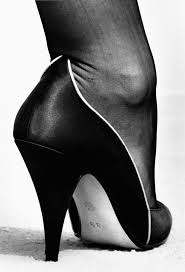
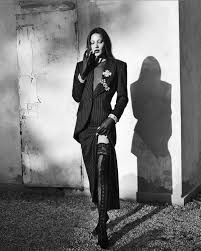
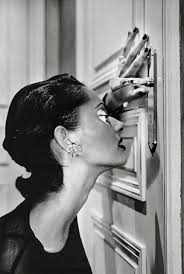
All of Newton’s images have been photographed in black and white as it aligned with his artistic vision and the provocative aesthetic he aimed to convey to the viewer. The use of black and white imagery has a timeless effect which accurately demonstrates the time period in which Newton was photographing. This time period (1950s) also reflects when women were only seen as objects of male desire and existed purely to visually please men. The women he photographed were presented in a way that felt both classic and enduring which aligned with the high-fashion world he worked in. In addition, by removing colour from his images it allowed the lines, shapes and shadows to be emphasised without any distractions from colours. This effect heightened the sensuality and strength, as well as drawing the viewers attention primarily to the women and their clothing in the images.
Critiques of Newton and his work:
Although Newton is undoubtably a successful and celebrated photographer, he has also been criticised for his provocative aesthetic which includes many bold aspects of eroticism and power within women. This is due to the fact many of his images show women in a way that emphasises their bodies, or are wearing minimal clothing. Although the artist’s overall aim is to allow women to feel more powerful, some critics argue that his work objectifies them, reducing them to only figures for the male gaze rather than presenting them as autonomous subjects to create an equal balance between genders in the media. One of the main elements showcased throughout Newton’s work is his subjects dressed in high heels and wearing lots of leather. Some see this as an exploration of female empowerment as it allows them to appear confident, yet many argue that Newton is reinforcing and conforming to the traditional power imbalances between men and women, forcing men to view the subjects in his photos as submissive.
In other ways, Newton’s work has also been criticised. This is through the repetition he uses throughout his images, as they all reflect similar vibes to one another due to the high contrast, black and white and including females who have a similar body type. Whilst these themes are iconic and allowed him to stand out from other feminist photographers, yet they are formulaic and sometimes predictable as there isn’t a huge variety of exploration.
Despite these critiques, I believe the subjects in Newton’s models did present lots of power and were able to challenge the societal norms surrounding how women ‘should’ behave or appear, as it is clear throughout his images that the women do hold power to a strong extent. My ideas can also be seen through the settings of his shoots, many of which are outdoors and appear luxurious, showing these women have important roles, which makes the viewer believe they are intelligent and have a high status. This is a significant feature of this specific type of photography because traditionally women were only useful in their homes to either cook, clean or nurture families, and Newton effectively challenges these associations which tells me he worshipped women and shows his admiration through his work.
Image analysis:
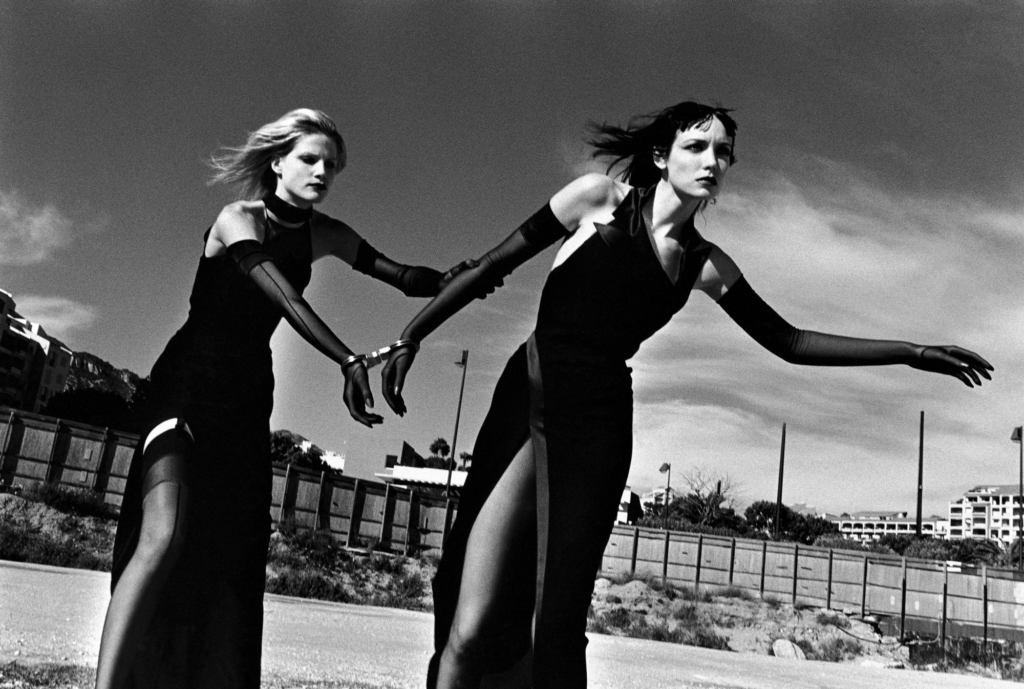
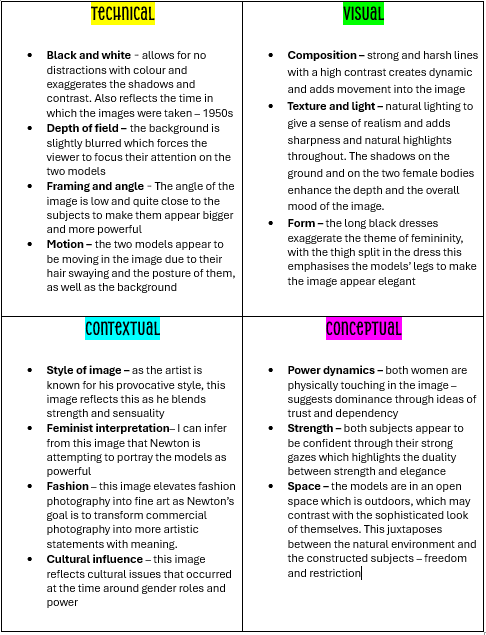
This image by Helmut Newton perfectly portrays his interests and themes of power dynamics and sensuality. In this specific image, my eye is immediately draw to the two models in the foreground. They are both dressed in sleek, black gowns with thigh splits which enhances the elegancy of the overall image. Both subjects are wearing long gloves which allows them to appear more sophisticated, and they both have a focused facial expression which adds to the theme of power as this gives off the effect that they are important and perhaps educated. This is an effective presentation of the message Newton is suggesting about power roles and equality between genders, as historically women were not allowed an education. This ideology contrasts with the image above as I can infer that both women feel confident and dominant rather than weak and vulnerable, which is how they were usually portrayed in photography. Both models are handcuffed together, which suggests there is a close relationship or bond between them. The woman in front has an extended arm, implying that she wants to walk forward. The woman behind her looks as if she is firmly holding her arm which creates a sense of tension or resistance.
The background in the image is an open, outdoor space with fencing and architecture. The use of this is to contrast with the styling of both the subjects as they are dressed dramatically, and the background appears rugged. The wind is sweeping through both if the models hair which enhances the sense of motion throughout the image, which overall gives it a more natural effect.
This image uses sharp contrasts throughout, contributed by the black and white imagery added. The lighting in the image is very strong as they are outdoors, using natural sunlight. This helps to sculpt both of the figures, which allows them to stand out and appear more important in the image, which again reinforces Newton’s main objective of women empowerment. There is a slightly low camera angle, which adds to the sense of dominance as the women appear to be higher up in the frame, suggesting a high status.
Overall, this image by Helmut Newton successfully captures a moment of elegancy, where both subjects appear significant and sophisticated through their clothing and expression.
